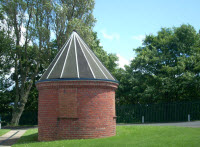 On Thursday 23rd conditions were again clear, however on this occasion the Bruce Observatory at the college served as our observing location. John, Keith and Mark ventured up to see how Jupiter, Saturn and Mars fared in the Cooke refractor. Proceedings were not as straight forward as hoped for.
On Thursday 23rd conditions were again clear, however on this occasion the Bruce Observatory at the college served as our observing location. John, Keith and Mark ventured up to see how Jupiter, Saturn and Mars fared in the Cooke refractor. Proceedings were not as straight forward as hoped for.
The first issue encountered was lack of light to see by, the electric to the observatory having been turned off within the college. Phone light and a wind-up torch had to suffice...oh and moon light. The next problem encountered was the refractor’s drive mechanism, which kept stopping. Luckily the illumination we had was enough for Keith to notice the drive box, which houses the governor balls and from which the pulley and weights are suspended, was out of alignment, suffering from a hefty knock we reckoned. Once re-aligned we were back in business, furthermore as we observed, the telescope speed control (which was also way off) was adjusted to a much better degree of accuracy allowing objects to stay centred longer in the eyepiece.
As for actual observations, well Jupiter, was difficult to acquire being low down in a position awkward for the sitting of the steps (over the step well) but we persevered. The image was ok, but we have seen much better for this apparition. Saturn was rather more satisfactory, with the Cassini division clearly evident as too was Titan and tantalizing glimpses of another moon – perhaps Rhea. Mars was also not bad, considering its low altitude. Surface makings were evident, but the turbulent air certainly tested patience at the eyepiece.
The gibbous Moon was a grand sight, with the bright crater Aristarchus catching the eye along with its near neighbour Herotodus, which is attached to the Vallis Schröteri and the sinuous rille system known as Rima Aristarchus. The night was rounded off by taking in Alberio; beta cygni – a glorious spectacle before finally ending observations with epsilon Lyra – the ‘double double’ in Lyra. All in all a good 90 minutes spent in the observatory.
- Log in to post comments
